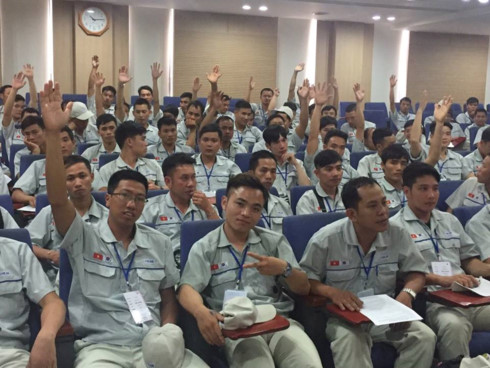[ad_1]
Vietnam had 134,751 guest workers employed abroad last year, exceeding the set target by 28.3% and equivalent to 106.7% of 2016’s figure. 2017 set a record as the fourth consecutive year that Vietnam has had more than 100,000 workers in foreign job markets.

Last year, several foreign labour markets recruited new careers for many of the positions Vietnamese guest workers were perfectly poised to meet demand, such as nursing assistants and orderlies, workers in agriculture and aquaculture, and highly-qualified and skilled workers.
Pham Viet Huong, deputy director of the Department of Overseas Labour Management (DOLM), says the 28.3% increase in labour exports, surpassing the level of 100,000 recorded one year earlier shows good signs for maintaining and developing traditional markets and expanding into new ones.
Numerous overseas employment service providers have stayed active in developing labour export markets by heavily investing in workers foreign language and skills training before sending them abroad. This has been typically evident when sending apprentices, orderlies, and nursing assistants to Japan. At the same time, major attention has been paid to improving the quality of officials and staff directly involved in labour export activities.
According to the DOLM, some key markets for exported labour, such as Taiwan (China) and Japan, continued to recruit large numbers of Vietnamese guest workers in 2017 while other markets also had stable recruitment demands.
Taiwan led the way for markets employing Vietnamese guest workers with 66,926 hosted in 2017, making it the second consecutive year that numbers of Vietnamese guest workers exceeded 60,000, accounting for nearly half of all workers employed abroad. The market share for Vietnamese workers in Taiwan has steadily grown year by year and by the end of November 2017, 206,184 Vietnamese were sent to Taiwan, occupying 30 of the market, trailed by Indonesia.
Meanwhile, Japan has come to be considered as a market offering the great potential for good working conditions, multiple choices for fields and industries, and a high income. It has been one of the most thriving markets for foreign labour after Taiwan.
Mr Huong says despite being seen as a demanding market, Japan remains the major target of Vietnam’s labour exports as shown by the increased number of Vietnamese guest workers year-on-year, from 27,000 in 2015 to nearly 40,000 in 2016. By the end of last year, the number of apprentices sent to the country amounted to 54,504, equivalent to 136.47% of 2016’s figure thus bringing the total number of Vietnamese apprentices to more than 100,000, with Vietnam overtaking China with the highest number of apprentices worked in Japan out of 15 other sending nations.
Other markets employing Vietnamese guest workers included the Republic of Korea (5,178), Saudi Arabia (3,626), Malaysia (1,551), Algeria (760), and Romania (683).
Such strong results from labour exports were attributable to the efforts of the Ministry of Labour, Invalids, and Social Affairs in carrying out measures, such as organizing a conference early the year with 280 labour export businesses to discuss how to best facilitate their operations, and possible improvements to the functions of labour exporters, their services, and guest workers.
Within the framework of Prime Minister Nguyen Xuan Phuc’s visit to Japan and his attendance at the Future of Asia Conference, the Vietnamese and Japanese governments signed a Memorandum of Cooperation (bilateral agreement on the technical intern training program on June 6, 2017).
With a stable trend targeting high income markets like Japan, the Republic of Korea, Germany, and Australia, the remittances of Vietnamese guest workers have increased annually to become a contributing factor in the sustainable reduction of poverty and the development of new rural areas.
VOV
[ad_2]
Source link
